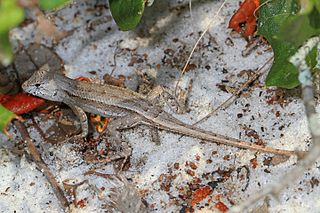Related Research Articles

Teiidae is a family of Lacertoidean lizards native to the Americas. Members of this family are generally known as whiptails or racerunners; however, tegus also belong to this family. Teiidae is sister to the Gymnopthalmidae, and both families comprise the Teiioidea. The Teiidae includes several parthenogenic species – a mode of clonal reproduction. Presently, the Teiidae consists of approximately 150 species in eighteen genera.

Spiny lizards is a common name for the genus Sceloporus in the family Phrynosomatidae. The genus is endemic to North America, with various species ranging from New York, to Washington, and one occurring as far south as northern Panama. The greatest diversity is found in Mexico. This genus includes some of the most commonly seen lizards in the United States. Other common names for lizards in this genus include fence lizards, scaly lizards, bunchgrass lizards, and swifts.

Crocodilurus is a monotypic lizard genus consisting of one species, Crocodilurus amazonicus, belonging to the family Teiidae. Its common name is the crocodile tegu, due to its appearance and fondness for water, and is locally known as the jacarerana. This semi-aquatic, predatory lizard has a flattened, paddle-like tail, enabling it to swim with ease. Also it has a red coloration on its tail

Tupinambis is a lizard genus which belongs to the family Teiidae and contains eight described species. These large lizards are commonly referred to as tegus. T. merianae, T. rufescens, and T. teguixin are popular in the pet trade. They are primarily found in South America, although T. teguixin also occurs in Panama.

The Mescalero Ridge forms the western edge of the great Llano Estacado, a vast plateau or tableland in the southwestern United States in New Mexico and Texas. It is the western equivalent of the Caprock Escarpment, which defines the eastern edge of the Llano Estacado.

Sceloporus poinsettii, the crevice spiny lizard, is a species of small, phrynosomatid lizard.

The sagebrush lizard or sagebrush swift is a common species of phrynosomatid lizard found at mid to high altitudes in the western United States. It belongs to the genus Sceloporus in the Phrynosomatidae family of reptiles. Named after the sagebrush plants near which it is commonly found, the sagebrush lizard has keeled and spiny scales running along its dorsal surface.

James Ray Dixon was professor emeritus and curator emeritus of amphibians and reptiles at the Texas Cooperative Wildlife Collection at Texas A&M University. He lived in El Campo, Texas, throughout most of his childhood. He published prolifically on the subject of herpetology in his distinguished career, authoring and co-authoring several books, book chapters, and numerous peer reviewed notes and articles, describing two new genera, and many new species, earning him a reputation as one of the most prominent herpetologists of his generation. His main research focus was morphology based systematics of amphibians and reptiles worldwide with emphasis on Texas, US, Mexico, Central America, and South America, although bibliographies, conservation, ecology, life history and zoogeography have all been the subjects of his extensive publications.

The six-lined racerunner is a species of lizard native to the United States and Mexico.
Hobart Muir Smith, born Frederick William Stouffer, was an American herpetologist. He is credited with describing more than 100 new species of American reptiles and amphibians. In addition, he has been honored by having at least six species named after him, including the southwestern blackhead snake, Smith's earth snake, Smith's arboreal alligator lizard, Hobart's anadia, Hobart Smith's anole, and Smith's rose-bellied lizard. At 100 years of age, Smith continued to be an active and productive herpetologist. Although he published on a wide range of herpetological subjects, his main focus throughout his career was on the amphibians and reptiles of Mexico, including taxonomy, bibliographies, and history. Having published more than 1,600 manuscripts, he surpassed all contemporaries and remains the most published herpetologist of all time.

The Argentine black and white tegu, also known as the Argentine giant tegu, the black and white tegu, or the huge tegu, is a species of lizard in the family Teiidae. The species is the largest of the "tegu lizards". It is an omnivorous species which inhabits the tropical rain forests, savannas and semi-deserts of eastern and central South America. They are native to southeastern Brazil, Uruguay, eastern Paraguay, and Argentina.
Sceloporus arenicolus, the dunes sagebrush lizard, formerly known as the sand dune lizard and the dunes-sagebrush lizard, is an insectivorous spiny lizard species which only occurs in the shinnery oak sand dune systems of southeast New Mexico and only four counties in adjacent Texas.

The Florida scrub lizard is a species of lizard in the family Phrynosomatidae. The species is endemic to Florida, the United States.
Wyoming is home to 12 amphibian species and 22 species of reptiles.

Slevin's bunchgrass lizard is a species of lizard in the family Phrynosomatidae. The species is indigenous to the southwestern United States and adjacent northern Mexico.

Salvator is a genus of lizards known as tegus which belong to the family Teiidae. The genus is endemic to South America.
Paradracaena is an extinct genus of lizards from northern South America. Fossils of Paradracaena colombiana have been found in the Honda Group of Colombia, Peru and Brazil. The species was described as a member of the tegus; Tupinambis huilensis by Estes in 1961.
References
- ↑ "Minutes of the Board of Trustees Meeting of the Herpetologists' League" (PDF). Archived from the original (PDF) on 2012-04-26. Retrieved 2011-11-22.
- ↑ Texas Cooperative Wildlife Collection "Dr. Lee Fitzgerald" Archived 2012-05-04 at the Wayback Machine Retrieved on 2 October 2011.
- ↑ Student Lineage ties Dr Fitzgerald to Dr Snell
- ↑ THS Lizard Symposium Schedule
- ↑ Distance sampling underestimates population densities of dune-dwelling lizards
- ↑ Texas A&M "Lab Publications" Retrieved on 2 October 2011.